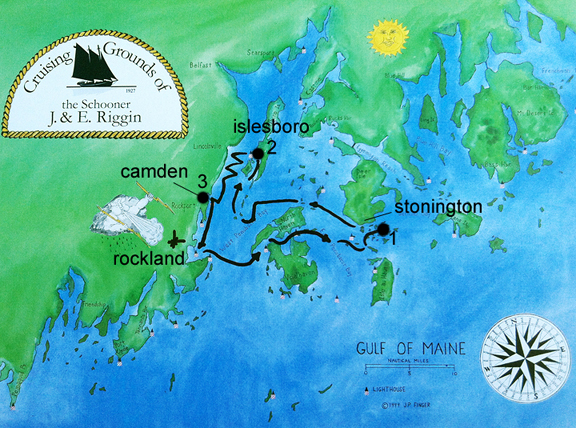travel: maine by sea (long)
Thursday, September 6th, 2012 Recipe: artichoke roasted pepper crab dip
Recipe: artichoke roasted pepper crab dip
***Jump to the recipe section***
I grew up sailing in southern Virginia since the age of nine, but living in Colorado doesn’t present many (any) opportunities to sail. So it was a huge enticement for me when part of my trip to Maine included a 4-day (4-night) cruise aboard The Schooner J. & E. Riggin, a historical landmark as decreed by the National Park Service. You can find the recap of the first half of my trip to Maine (the part on land) here.

Full disclosure: The Maine Office of Tourism and The Schooner J. & E. Riggin sponsored my transportation, lodging, and meals with no obligation on my part. All photographs, words, experiences, and especially opinions, are my own.
Day 4: Rockland, Russ Island, Lobster Bake
Day 5: Stonington, Islesboro
Day 6: Camden
Day 7: Rockland
Day 4: The Riggin was originally an oyster boat, built in 1927 and converted to a passenger boat in 1977. Now when I say cruise, I should note that this is not the kind of cruise that most people envision when they hear that word. It’s a real sailboat and guests participate in many of the manual operations on deck (no motorized winches or even winches for that matter) and partake of chores like dish duty. The sleeping quarters remind me of camping… but different. Each cabin has a small sink with cold running water and there are two communal heads (bathrooms) above deck which require manual flushing and minimal use of toilet paper (8 squares max per flush, kids). One of the heads doubles as a shower stall.
rockland

down the hatch leading to my cabin

where i slept

It’s an adventure, and if you’re game – it is a tremendous experience.
Before we set sail in the morning, chef and co-captain Annie Mahle (wife of Captain Jon Finger) and her galley crew, prepared a hearty and beautiful breakfast of banana cardamom pancakes with cinnamon pecan coffee syrup, fruit, and bacon for everyone. Maine boasts the largest windjammer fleet in the United States, but the Riggin is only one of two that has an actual chef on board. Annie has authored two cookbooks: At Home, At Sea: Recipes from the Maine Windjammer J&E Riggin and her latest book Sugar & Salt: A Year at Home and at Sea. Most of what is served aboard the Riggin is locally sourced and masterfully prepared in a closet-sized kitchen on a wood-burning stove under the restrictions of limited water usage (there is a finite amount of fresh water on board). Annie does not waste food, the Riggin composts as much as possible, and tries to keep trash to a minimum.
breakfast was served below in the galley

you can’t not love a woman serving a heaping pile of bacon

Sharon joined us for breakfast, but hugged us good-bye before we set sail, leaving us in the care of Captain, Annie, and the crew. I learned from Captain that there is no set agenda per se, that they sail based on the wind.
first mate, scott or “scoot”, keeps it tidy

scott and ian do a safety demo

the galley is small, but everyone congregates there

Once we cleared the harbor, passengers were asked to help the crew raise the sails. It was a bluebird day with steady winds as Captain sailed us across West Penobscot Bay past North Haven and through East Penobscot Bay. Annie served up a lunch of Asian rice noodles, cilantro and coconut duck, salmon zucchini rice cakes, and a whole slew of fresh vegetables and pickles on deck as we sailed. We set anchor just off Russ Island and Annie gave us a lesson on lobsters.
ian and scott on the throat

tying off the sheet

sails

we got schooled

Captain shuttled us from the Riggin onto Russ Island where Annie and crew had set up a lovely spread of crudités, bacon blue cheese dip, watermelon, chips, and homemade apple cider. While the crew prepared for the lobster bake, Annie and Captain sat with their youngest, Ella, for some quality reading time together. Ella is part of the crew and you would be hard-pressed to meet an eleven year old as mature, hard-working, talented, and sweet as her. It’s a testament to the loving environment that her parents have provided for her. The kid is awesome.
appetizers

boiling the lobsters

family time

**Jump for more butter**





 Recipe: spicy tuna roll burger
Recipe: spicy tuna roll burger














 Recipe: blackened salmon sandwich
Recipe: blackened salmon sandwich











